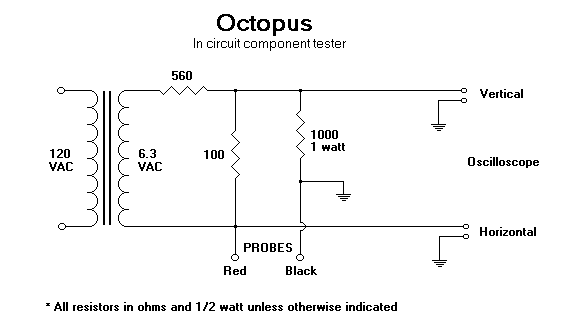Do you have an oscilloscope and you never use it?Don’t sell it, now I will explain how to turn it into a simple but effective component tester.
The name “Octopus” maybe doesn’t say anything alone but if you google it along the words “curve tracer” you will obtain thousands of result.In few words an “Octopus” curve tracer is a small circuit that used in conjunction with a scope allows to display the voltage across a component under test on horizontal (X) axis versus the current through that component on the vertical (Y) axis.A scope set to X-Y mode is required (most of them have this feature).
There are lot of variants of “Octopus” circuit, personally I choose this one:

since it applies small voltage (less than 1VAC) and current (less than 1mA) allowing to test unpowered components also in circuit without risk of damaging them.
As you can from picture above circuit is made of very few common parts : there is a transformer 120VAC to 6.3VAC ( I’m in Europe so I used a 220VAC one), three resistors (the 560 Ohm and 100 Ohm ones forms a voltage divider to obtain 1VAC , then the 1KOhm one limits current to 1mA) and two probes.
This circuit will produce a “signature” waveform on the oscilloscope to aid in the testing and analysis of shorts, opens, and leakage in just about any electronic component including resistors, capacitors, inductors, diodes,transistors and digital ICs too.Each component has a characteristic waveform (called “Lissajous” pattern), some examples:

Now, you will wondering what this device has to do with arcade?Well, personally I find it very uself when I probe ICs out of circuit.For example, in my last repair I was unsure if a 74LS367 was good or not since I got discordant results from my testers.Probing it with the curve tracer and comparing its patterns with the ones of a good known IC removed all doubts:
On the right the pattern generated from a good IC (74LS367), on the left the one from the defective one.Specifically you can see how the junction (internally a TTL contains transistors) of an output (PIN9) is weakened compared to the good one (pattern doesn’t have the healthy ‘L’ shape of a good diode/base to collector junction)
Obviously this curve tracer can be used also to test components in-circuit (thanks to the low voltage/current applied) but in this case experience is needed as components can interact each other producing misleading results.The best option would be having a good board as reference.
If you want to read more about, I recommend you this document:
https://www.qsl.net/kd7rem/pdf/octopus.pdf
So, what are you waiting for?Go and build your “Octopus”! 🙂
5 Responses to “Dirty cheap component tester (a.k.a. “Octopus” curve tracer)”
Sorry, the comment form is closed at this time.


Hello,
As always in this website, usefull infos, thanks.
Just a few words to say a lot of Hameg oscilloscopes can do the same thing without anytthing more than the scope because of built-in “commponent tester” function. For example I had a HM-203 with this functionnality.
Fabien
Thanks for your comment.
Yes, I was aware of this feature on many scopes like the Hameg ones.By the way, do you know which kind of signal your HM-203 apply to device under test?
Sorry, I sold my scope about one year ago 🙁
OK.I’ll try to find its manual on the net hoping there are technical specs.
You’ll find some pdf on the net, I’ve one in french, (but also have in english) with schematics in case you don’t find what you’re searching for